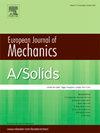Design and mechanics of stackable auxetic S-shaped structures
IF 4.2
2区 工程技术
Q1 MECHANICS
引用次数: 0
Abstract
The emerging auxetic lattices, driven by contemporary advancements in additive manufacturing, have garnered significant attention, with an emphasis on improving structural performance and energy absorption efficiencies while mitigating the contributions of material nonlinearities and instabilities. This research advances the state of the art of thin-strut auxetic structures by introducing a stacking schema to realize 3D S-shaped polystructures with rigid-body motion-dominated deformation, spatial symmetry, and persistent auxeticity. Several generations of these polystructures were 3D printed using vat photopolymerization with varying strut thickness ranging from 1 mm to 3 mm. The additively manufactured structures were mechanically tested under quasi-static and impact loading scenarios, providing physical evidence for the foreseen structural behaviors discussed above. The polystructures yielded load-bearing-to-mass ratios of 4.6 kN/kg, 7.6 kN/kg, and 12.3 kN/kg for t1, t2, and t3, respectively, with less than 10 g of weight, a result of the rigid body motion and the asymmetric rotation of the polystructure beams. Additionally, the impact response highlighted a structure-to-material transition, resulting in similar force maxima for t1 and t2, with 9 and 10 N (structure-dominated), whereas t3 reported a force of up to 49 N (material-dominated). However, irrespective of the strut thickness, the negative Poisson's ratio remained nearly unchanged (−0.22 ± 0.02), exemplifying the importance of the structural mechanics substantiated by the specific topological design of S-shaped unit cells. The research findings paved the way for the translational potential of S-shaped polystructures in practical applications for mitigating impact, including civilian and military loading conditions.
可叠层消声s形结构的设计与力学
在当代增材制造技术进步的推动下,新兴的增材晶格引起了人们的极大关注,其重点是提高结构性能和能量吸收效率,同时减轻材料非线性和不稳定性的影响。本研究通过引入一种叠加模式来实现具有刚体运动主导变形、空间对称和持久形变的三维s形多结构,从而推动了薄杆形变结构的发展。使用还原光聚合技术3D打印了几代这些多结构,其支撑厚度从1毫米到3毫米不等。在准静态和冲击载荷情况下对增材制造的结构进行了力学测试,为上述预测的结构行为提供了物理证据。由于刚体运动和多结构梁的不对称旋转,在t1、t2和t3阶段,多结构梁的承重质量比分别为4.6 kN/kg、7.6 kN/kg和12.3 kN/kg,重量小于10 g。此外,冲击响应突出了结构到材料的转变,导致t1和t2的最大作用力相似,分别为9和10牛(结构主导),而t3报告的力高达49牛(材料主导)。然而,无论支撑厚度如何,负泊松比几乎保持不变(- 0.22±0.02),这说明了s形单元胞的特定拓扑设计所证实的结构力学的重要性。研究结果为s形多结构在实际应用中的转化潜力铺平了道路,以减轻影响,包括民用和军用载荷条件。
本文章由计算机程序翻译,如有差异,请以英文原文为准。
求助全文
约1分钟内获得全文
求助全文
来源期刊
CiteScore
7.00
自引率
7.30%
发文量
275
审稿时长
48 days
期刊介绍:
The European Journal of Mechanics endash; A/Solids continues to publish articles in English in all areas of Solid Mechanics from the physical and mathematical basis to materials engineering, technological applications and methods of modern computational mechanics, both pure and applied research.

 求助内容:
求助内容: 应助结果提醒方式:
应助结果提醒方式:


